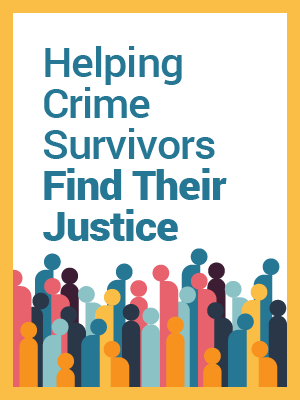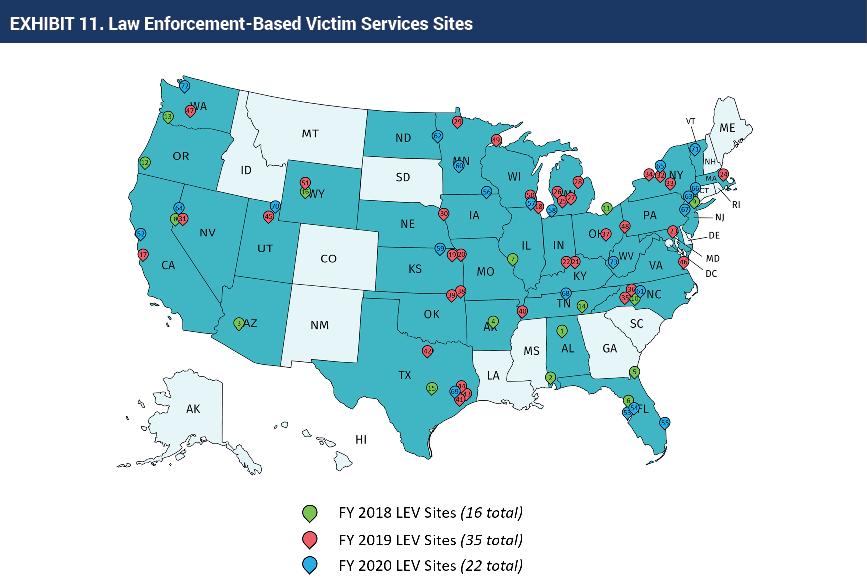Archival Notice
This is an archive page that is no longer being updated. It may contain outdated information and links may no longer function as originally intended.
Support for Law Enforcement
OVC supports partnerships with law enforcement agencies at the state, Tribal, and local levels to combat crime, promote safer neighborhoods, and establish collaborations between police and the communities they protect. Through discretionary grant programs, OVC grantees help agencies provide effective, trauma-informed law enforcement practices to better serve all victims. OVC also funds national-scope discretionary programs to provide comprehensive services to victims and family members in the aftermath of crime. These national-scope initiatives help demonstrate the benefits of law enforcement efforts in addressing the needs and rights of victims of crime.
Law Enforcement-Based Victim Services
Since FY 2018, OVC has awarded over $30 million to more than 70 project sites—including more than 20 awards in FY 2020—to develop or enhance victim assistance service programs within law enforcement-based systems through the Law Enforcement-Based Victim Services Program (LEV) (see exhibit 11). This program intends to better coordinate partnerships with community-based programs to serve the broader needs and rights of all crime victims with the goal of increasing the number of victim services programs in state, local, and Tribal law enforcement agencies.
There were 58 active LEV grantees during FYs 2021 and 2022. These grantees served 61,325 victims of crime (both new and returning), with 45,880 individuals who received services for the first time. Domestic or family violence (36 percent); adult physical assault (27 percent); and survivors of homicide (6 percent) were identified as the most common victimization types. Law enforcement grantees provided services across all categories, and the most commonly requested services included information about the criminal justice process (41,848 occurrences); information about victims’ rights (38,250 occurrences); and individual advocacy (22,780 occurrences). On average over these 2 years, 306 partners were involved in these programs per quarter.
In addition to victim services, the TTA provided included 98 trainings completed with 2,277 participants, including victim service providers, law enforcement, victim advocates, and community-based organizations. Of the trainings completed, 538 feedback surveys reported 99 percent overall satisfaction and a 95 percent increase in knowledge. There were also 882 technical assistance requests completed, supporting 12,724 recipients.
Twenty-three sites funded in either FY 2018 or FY 2019 have transitioned their LEV-funded positions to agency-funded positions. Another seven have identified alternate grant funding sources. Other site accomplishments include the following:
- In Tennessee—
- The Memphis Police Department is working with Casa Luz, an OVC-funded Enhancing Access to Services grantee, to provide language access and cultural sensitivity training at the Memphis PD Police Academy, and improve supports offered to Latino domestic violence and sexual assault victims in Memphis.
- The Chattanooga Police Department has seen that the collaborative relationship between sworn personnel and Victim Services Unit personnel provides expedited services for victims, including safety planning, behavioral/mental health referrals, and connections to appropriate community-based services. Training provided by victim services personnel has expanded agencywide understanding of victim-centered, trauma-informed practices, which has strengthened the skills of sworn personnel and improved their response to victims.
- The Salt Lake City Police Department in Utah transitioned victim services from a unit to a full division within the department.
Since FY 2019, the International Association of Chiefs of Police (IACP) has been awarded nearly $5 million to serve as the training and technical assistance (TTA) provider for the sites funded under this program. In 2020, IACP partnered with the Justice Research and Statistics Association (now Justice Information Resource Network) to gain a better understanding of the full landscape of law enforcement-based victim services through three undertakings: the victim services mapping project, mini-grant research opportunities, and case studies. Reports for these projects were released in FY 2022.
- Final Report on the Survey of Law Enforcement-Based Victim Services (December 2021): This survey aimed to gain knowledge of the landscape of law enforcement-based victim services throughout the country. Results from this survey illuminate the current state of law enforcement-based victim services and identify needs for technical assistance and future research directions. Results can also help identify common practices in this growing field and support program development and sustainability.
- IACP LEV Case Studies Report (January 2022): This report presents the findings from six case studies of LEV programs. The research was conducted between April and July 2021 and explored the organizational structure, functioning, and service delivery process of the LEV grantees, and identified their strengths and challenges in service provision. The lessons learned from the case studies offer insight into and recommendations on how law enforcement can successfully develop, implement, strengthen, sustain, and expand victim services in their agencies.
Enhancing Law Enforcement Response to Crime Victims
Since 2003, OVC has partnered with IACP to improve law enforcement agencies’ responses to victims of crime. Through that partnership, IACP developed Enhancing Law Enforcement Response to Victims: A 21st Century Strategy (ELERV), published in 2009, and a second edition in FY 2020. The strategy illustrates how every person in a law enforcement agency has a role in effective victim response and introduces law enforcement leaders to the challenges, methods, responsibilities, and benefits of enhancing their response to victims of crime.
Implementing the ELERV Strategy can lead to broader communitywide trust and confidence in the police, foster the healing process for victims, increase victim participation in the criminal justice process, and produce stronger, more comprehensive cases to hold offenders accountable. To further this work, OVC selected a Fellow in FY 2022 who will identify ways in which OVC can promote the adoption of the ELERV strategy by law enforcement agencies throughout the country.
Responding to Gender-Based Violence
In FY 2019, OVC awarded more than $600,000 to IACP to provide support, guidance, and technical assistance to six law enforcement agencies as part of the Integrity, Action, and Justice: Strengthening Law Enforcement Response to Domestic and Sexual Violence Demonstration Initiative. During FY 2021 and 2022, IACP provided training and technical assistance for selected pilot and demonstration agencies to identify gender bias within their agencies and enhance their responses to gender-based violence. IACP also developed resources for law enforcement agencies, including
- 10 Things To Know
- Five Things Supervisors Can Do
- Gaining Buy-In, Building Trust, and Operationalizing Values
Addressing Trauma
Many first responders and victim service providers are affected by vicarious trauma, defined as the exposure to the traumatic experiences of other people, because of their repeated exposure to crime victimization. In FY 2019, OVC provided $3 million in funding to the IACP for the Vicarious Trauma Response Initiative to identify and develop skills and practices needed to promote healthy, comprehensive, and sustained collaborative approaches that buffer and mitigate the negative effects of vicarious trauma.
Through the initiative, IACP is providing dedicated resources, training, and technical assistance to communities seeking to build interdisciplinary, cross-agency collaborations to assess and address the impact of vicarious trauma on their respective staff. The online training suite is accessible to more than 79 organizations within the project sites, and 58 organizations from 12 project sites completed the Vicarious Trauma Organizational Readiness Guide (VT-ORG) before developing their implementation plans. The assessment results provided an overview of organizational strengths and relevant gaps, serving as a roadmap for areas that could be communally addressed throughout the initiative.
In FY 2021 and 2022, the vicarious trauma response grantee collaborated with an average of 117 partners and an average of 90 partners due to grant funding. There were 55 trainings conducted for 1,054 participants, including victim service providers, law enforcement, victim advocates, and community-based organizations.
Implementation Site Highlights
- The 12 implementation sites worked together to develop a brown bag training series, allowing them to share the cost and logistics of hosting a training while ensuring the knowledge gained was accessible to all project peers nationwide.
- The Cleveland, Ohio, site developed a vicarious trauma exposure training for law enforcement that was held 15 times and reached more than 270 attendees. Evaluations showed that 92 percent of respondents better understood the concept of vicarious trauma.
- The Denton, Texas, site created a Staff Health and Wellness Committee to improve organizational responses to vicarious trauma.
- The Maywood, Illinois, site established, trained, and launched a peer support team for the Maywood Police Department. They have six officers trained for peer support and a clinician/community liaison. Based on its success, the initial peer support unit has been expanded to include a neighboring community’s police department and dispatch.
- The Washington, D.C., site held a month-long virtual wellness fair for staff called the Month of HEART (Helping Everyone Acknowledge and Respond to Trauma). They also held weekly peer support sessions and offered self-care and wellness workshops to introduce new practices for processing stressful work experiences and building resilience.
- The Birmingham, Alabama, site raised awareness of vicarious trauma within their community to the point where it is now included in the orientation and hiring practices of the Jefferson County Sheriff’s Office, Birmingham Fire and Rescue Service, Jefferson County District Attorney’s Office, and the Birmingham Police Department.
- The Clackamas, Oregon, site implemented a Wellness Coaching Pilot Program for staff that focused on the physiology of trauma and how vicarious trauma impacts individuals, how we can intervene on a group basis, and the development of wellness plans. Ninety percent of participants agreed that they felt informed about ways to mitigate vicarious trauma.
- Norman, Oklahoma, created a vicarious trauma library with 25 titles that different organizations will be allowed to check out.
Research suggests that increasing hope in the workplace may mitigate the adverse effects of burnout and secondary traumatic stress. Hope science focuses on positive expectations for the future and is positively correlated with well-being. A hope-centered framework developed collaboratively by law enforcement and the community can build trust between officers and the people they serve.
In FY 2021, OVC awarded $2.5 million under Fostering Resilience and Hope: Bridging the Gap Between Law Enforcement and the Community. This program supports the development of a Community of Practice (CoP), a system of critical inquiry and reflection focused on building shared learning over time, with different types of law enforcement officers from rural and underserved areas. The CoP is led by the technical assistance provider Social Current.
In 2022, the CoP identified 25 law enforcement agencies to work on a hope-centered framework to assist law enforcement officers with addressing trauma and adversity in order to repair and rebuild relationships within the community. An evaluation is being conducted in tandem and will produce a final report showcasing best practice.
In FY 2021 and 2022, the grantee conducted 29 trainings with mental health providers and educators or youth service providers. In addition to training and technical assistance, four project deliverables were completed and three improvement initiatives were implemented, which included community awareness campaigns, training efforts, and development or deployment of new technology.
For additional information, visit OVC’s website.





